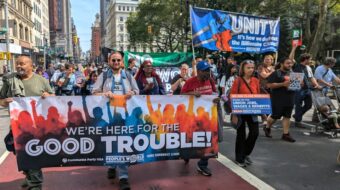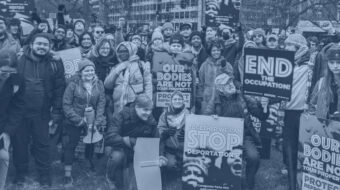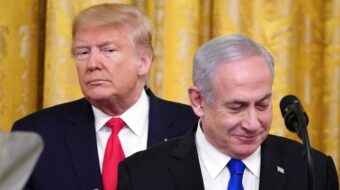The burgeoning peace movement – appropriately referred to as “the other superpower” by The New York Times – is faced with an urgent new task: preventing a new war against the Democratic People’s Republic of Korea (DPRK).
The Korean peninsula has run red with the blood of millions. The war against North Korea led by the United States in the early 1950s – a so-called UN “police action” – resulted in four million Koreans killed and the deaths of nearly 37,000 U.S. troops.
Countless civilians were victims of atrocities carried out by U.S. soldiers in both North and South Korea. In a number of articles, the Associated Press (beginning Sept. 29, 1999) revealed massacres of civilians at No Gun Ri and at several other locations in the south, confirmed by various U.S. veterans who had taken part in these killings. Napalm and germ warfare, along with a “scorched earth” policy, were employed by the U.S. and the South Korean forces it commanded.
July 27 marked the 50th anniversary of the armistice ending the fighting in that war. The U.S. refused to sign a peace agreement, which means that technically it is still in a “state of war” with North Korea.
Bush undermines efforts for peace
Due to the increasingly hostile policies of the Bush administration toward North Korea, the Korean people are facing the renewed threat of pre-emptive, and possibly nuclear, war. That menace extends to the region and the entire world.
In 2002, President-select George W. Bush abandoned the accord so critical to international peace and security, the ABM Treaty. He then proceeded with plans to build the National Missile Defense system and to deploy theater missile defenses, which the ABM treaty had proscribed. Bush and his entourage particularly used as their key justification for these moves an alleged nuclear threat from North Korea.
During his 2002 State of the Union address, Bush singled out North Korea along with Iraq and Iran as belonging to an “axis of evil,” accusing the DPRK of arming itself with missiles and weapons of mass destruction.
Later he unveiled his doctrine on pre-emptive strikes, directing the Pentagon to be prepared to use nuclear weapons against seven countries: Russia, China, Iraq, Iran, North Korea, Libya and Syria.
WMDs: White House lies facilitate war
High among Washington’s pretexts for waging pre-emptive war is “to eliminate weapons of mass destruction.” As we know, this was the excuse used for the war against Iraq, yet no such weapons have been found.
With each passing day the Bush administration’s claims about Iraqi WMDs are being exposed as fabrications. Nevertheless, having been through this fraudulent justification for the “shock and awe” invasion and destruction of Iraq, causing the deaths of countless thousands including many children, we are being barraged with the same kind of rationalization for war against Iran and North Korea.
U.S. military build-up
The U.S. has been building up its military presence in and around the Korean peninsula for a number of months. General Leon J. LaPorte, U.S. commander in South Korea, recently announced an $11 billion “force enhancement initiative.” At the same time, Washington has been exerting heavy pressure on the Republic of Korea (ROK) government to increase its military budget.
Recently, Deputy Secretary of Defense Paul Wolfowitz indicated that American troops would be withdrawn from the demilitarized zone, which The New York Times described as a move “to take them out of easy range of North Korean artillery, and theoretically position the United States to mount a pre-emptive attack against the North.” Pentagon officials have recently made clear that the changes were being made with the possibility of war in mind. This is in spite of the request by ROK President Roh Moo Hyun that the Bush administration postpone any redeployment of the Second Infantry Division until “after the nuclear issue has been resolved.”
North Korea “is teetering on the edge of economic collapse. … That, I believe, is a major point of leverage,” the Associated Press quotes Wolfowitz as saying.
Plan 5030
If this were not enough, the most recent issue of U.S. News and World Report reveals the details of a draft of a new Pentagon war plan – Plan 5030 – calling for provocative actions against North Korea. This includes conducting maneuvers and holding surprise military exercises in order to compel North Korea to place its troops on high alert. It also speaks of using spy planes to fly directly up to the border to force the DPRK to scramble its jet fighters. The aim is to strain the North Korean military’s scarce resources and to sow confusion. The very disclosure of plan 5030 is designed to further undermine the possibilities for a negotiated settlement.
Coupled with this is another publicly-known U.S. war plan – OPLAN 5027 – for launching a pre-emptive strike against the Yongbyon nuclear complex and other military targets.
Vast U.S. military presence
Meanwhile, the backdrop to the heightened war-mongering includes the ongoing presence of more than 40,000 U.S. troops and 97 bases and military installations in South Korea; regular U.S.-led war games; daily target bombing for 50 years at the bombing range near the village of Maehyang-Ri; crimes by members of the U.S. military against Korean citizens that go unpunished; and environmental destruction caused by these military forces, including the dumping of toxic wastes into the Han River, the drinking water source for millions of people. The U.S. continues to act as a virtual occupying force in South Korea operating under the Status of Forces Agreement.
The DPRK has been under direct nuclear threat longer than any other nation. During the Korean War, Gen. Douglas MacArthur had to be prevented from unleashing atomic bombs on North Korea. Throughout the Cold War, the DPRK faced the threat of U.S. nuclear weapons and up to 100 tactical nuclear warheads stationed south of the DMZ.
Openings to peace
Yet in recent years, after decades of unremitting struggle for democracy, peace, and reunification in South Korea, along with unprecedented massive general strikes by the labor movement, significant gains have been won. These include the election of governments considerably more answerable to the populace than the extremely repressive regimes of the past. Both President Kim Dae Jung, who projected his “sunshine policy” towards the DPRK, who met in the historic summit with President Kim Jong Il of the DPRK, and who, himself, had been a political prisoner, and the current President Roh, have supported implementation of the North-South Declaration in spite of strong pressures from Washington.
The Agreed Framework
During the Clinton presidency, according to then-Defense Secretary William Perry and Assistant Secretary of Defense Ashton Carter, an attack on the Yongbyon facility in the DPRK was being readied even though they acknowledged that the price would be very heavy, including for South Korea. “The intensity of combat would be greater than any the world has witnessed since the last Korean War.” (Bulletin of Atomic Scientists, Jan.-Feb. 1998)
Kim Young-Sam, then-president of the ROK, recalls, “At the time the situation was really dangerous. … The Clinton Government was preparing for war.” As American forces mobilized for an assault, Kim warned U.S. Ambassador James Laney that South Korea would not move “even a single soldier” in support of the U.S. war. Kim then phoned President Clinton and told him “there would be no inter-Korean war while I was president.”
Former President Jimmy Carter, who was alarmed over the dangerous march toward war, boldly intervened and made an unofficial trip to Pyongyang. He was instrumental in bringing about negotiations and created a fait accompli, which Clinton could not overturn. This ultimately led to the 1994 DPRK-U.S. Agreed Framework. (See sidebar.)
Nuclear Non-Proliferation Treaty
Under the Agreed Framework, the U.S. pledged to build one or more light water reactors in the DPRK and to supply much-needed “heavy oil” to that country to meet North Korea’s electricity and heating needs. In exchange, North Korea agreed to decommission its graphite moderated reactor program. The U.S. has effectively reneged on the agreement, creating enormous hardship for the people of the DPRK.
This led the DPRK to withdraw from the Nuclear Non-Proliferation Treaty (NPT) and to end the freeze on its reactor at Yongbyon and its program to construct of two more reactors. In so doing, they pointed to Article X, which stipulates: “Each party shall in exercising its national sovereignty have the right to withdraw from the Treaty if it decides that extraordinary events, related to the subject matter of this Treaty, have jeopardized the supreme interests of its country.”
Meanwhile, the U.S. possesses by far the largest arsenal of nuclear armaments – 8-12,000 warheads, many of which remain on hair-trigger alert. It has failed to abide by Article VI of the Non- Proliferation Treaty (NPT), requiring the nuclear weapons states, including the U.S., to accomplish the total and unequivocal elimination of their nuclear weapons. Washington is maintaining a double standard by demanding other nations respect the NPT while it possesses this vast arsenal and proceeds to develop new nuclear weapons.
The path to peace
Under these menacing circumstances, the DPRK is asserting its right to possess nuclear weapons to ensure its security if the U.S. continues threatening it.
Nevertheless, the DPRK reiterates its determination to seek a peaceful settlement of the nuclear issue, through negotiations. This is a goal shared by the government and majority of people of the ROK as well. Indeed, vast multitudes around the globe yearn for a peaceful resolution of this perilous confrontation.
If the U.S. had lived up to the Agreed Framework provisions, the current dangerous crisis could have been avoided. The people of North Korea would not be suffering so desperately from the lack of electric power, which is key to agricultural and industrial production – a hardship that was acutely exacerbated by a series of unprecedented natural disasters of flooding and drought. The economic suffering has been caused in no small way by the ongoing economic sanctions against the DPRK, imposed by the U.S. for years.
Public opinion in the U.S. has shifted dramatically in response to the untruths used to justify the war against Iraq. This should lead people to question such allegations with regard to North Korea and to reject fraudulent accusations about weapons of mass destruction used as pretexts for waging new wars.
The peace and justice movement in the U.S. and worldwide is raising the demand to prevent war on the Korean peninsula based on the following essential steps: (1) The U.S. immediately should resume negotiations with the DPRK, in good faith; (2) Return to the pledge contained in the Agreed Framework to renounce the threat or use of nuclear weapons and conclude a non-aggression pact; (3) Respect the will of the Korean people for the full implementation of the North-South Declaration of June 15, 2000, for achieving peace, reconciliation and reunification on the Korean peninsula.
* * * * * * * * * * *
Agreed Framework provisions
In accordance with the Agreed Framework, North Korea agreed to freeze its graphite-moderated reactor at Yongbyon and halt construction of two more reactors, to be monitored by the IAEA. The U.S. agreed to “undertake to make arrangements for the provision” to North Korea of a light water reactor (LWR) project. Thereby this would quell any notion that plutonium extracted from the Yongbyon facility was being utilized in the development of nuclear weapons, even though there had never been any evidence to that effect. Upon completion of the LWR project, the DPRK agreed “to dismantle its graphite-moderated reactors and the related facilities,” according to Article 5 of the Agreed Framework. (My emphasis.)
While the light water reactors were under construction, the U.S. was obligated to supply North Korea annually with half a million tons of heavy oil for heating and electricity production. These shipments were intended to serve as partial compensation to North Korea for being forced to abandon efforts to meet its energy needs critical to its economic development.
Furthermore, the Agreed Framework called for a “move to full normalization of political and economic relations.” And Article 3 states, “The U.S. will provide formal assurances to the DPRK, against the threat of use of nuclear weapons by the U.S.”
– Karen Talbot









